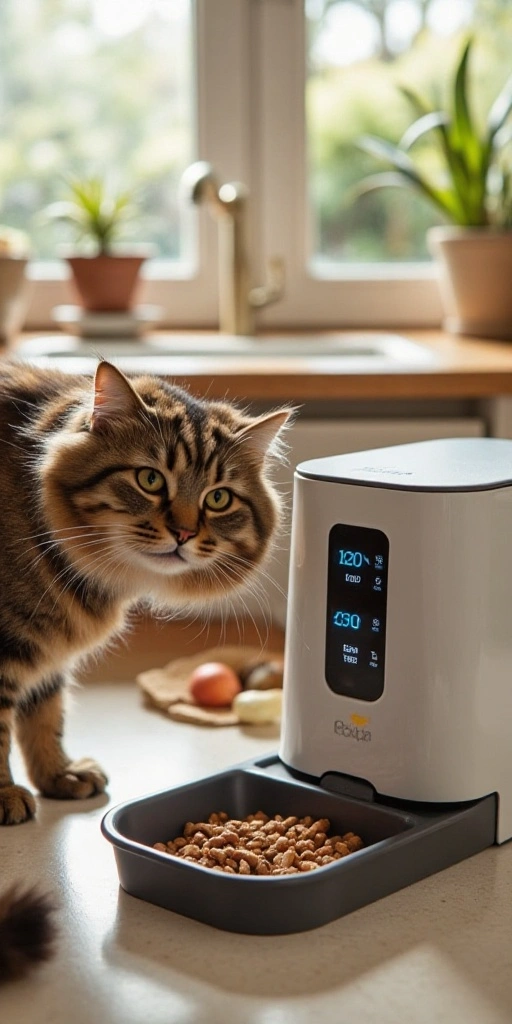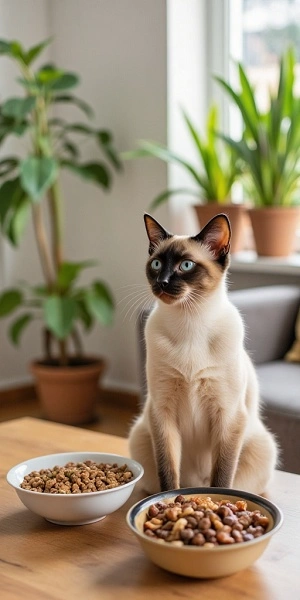Struggling with a cat that begs for food at odd hours or skips meals? Establishing a cat feeding schedule is a game-changer for promoting cat health, improving behavior, and ensuring optimal cat nutrition. A consistent routine supports your cat’s physical and mental well-being, reduces stress, and strengthens your bond with your feline companion. In this detailed guide, we’ll dive into why a regular feeding schedule is essential, how to create one, and the tools and products that can make it easier. Whether you’re a first-time cat owner or refining your approach, this article offers practical advice to help your cat thrive.

The Importance of a Regular Cat Feeding Schedule
Cats thrive on routine, and a structured cat feeding schedule taps into their natural instincts. In the wild, cats hunt at predictable times, creating a rhythm that domestic cats still follow. A consistent feeding routine offers multiple benefits for cat health and behavior:
- Better Digestion: Feeding at set times regulates the digestive system, minimizing issues like vomiting or constipation.
- Weight Control: Portion-controlled meals prevent overeating, critical since over 60% of U.S. cats are obese, leading to conditions like diabetes or joint pain.
- Reduced Stress: Predictable meals lower anxiety, curbing behaviors like excessive meowing or food aggression.
- Health Monitoring: A schedule makes it easier to spot appetite changes, which can signal illnesses like dental issues or kidney disease.
Without a schedule, cats may develop unhealthy eating habits, such as overeating cat food or becoming picky eaters, which can compromise their long-term health. A regular routine sets the foundation for a happy, healthy cat.
How to Create a Cat Feeding Schedule
Building a cat feeding schedule requires planning, consistency, and an understanding of your cat’s needs. Follow these steps to establish a routine that works for both you and your cat:
1. Assess Your Cat’s Nutritional Needs
Every cat has unique cat nutrition requirements based on age, weight, activity level, and health status. For example:
- Kittens: Need 3-4 meals daily to fuel growth and development.
- Adult Cats: Typically require 2-3 meals, depending on their size and energy expenditure.
- Senior Cats: May benefit from smaller, more frequent meals to support aging digestive systems.
A veterinarian can help determine your cat’s caloric needs. For instance, a 10-pound adult cat generally requires 200-250 calories daily, but this varies for active versus sedentary cats. Check cat food labels for feeding guidelines, but always consult a vet for personalized advice.
2. Select the Right Cat Food
The type of cat food you choose influences how you structure the schedule. Common options include:
- Wet Cat Food: High in moisture, great for hydration and urinary tract health, but spoils quickly and requires refrigeration after opening.
- Dry Cat Food: Convenient for portion control but can lead to overeating if not measured. Always provide fresh water alongside.
- Mixed Feeding: Combining wet and dry food offers nutritional variety. For example, wet food in the morning and evening with dry food at midday can balance hydration and convenience.
Choose high-quality cat food that meets Association of American Feed Control Officials (AAFCO) standards to ensure complete nutrition. Avoid low-quality brands with fillers, as they can harm your cat’s health over time.
3. Establish Fixed Feeding Times
Select meal times that align with your daily routine. For adult cats, two meals (e.g., 7 AM and 7 PM) or three meals (e.g., 7 AM, 1 PM, 7 PM) are effective. Consistency is key—cats quickly learn to expect food at these times, reinforcing the routine.
If your schedule is unpredictable, an automatic feeder can maintain consistency by dispensing food at programmed times. This is especially helpful for busy owners or cats with specific dietary needs.

4. Measure Portions Precisely
Overfeeding is a leading cause of feline obesity. Use a digital scale or measuring cup to portion cat food accurately. For example, a 10-pound cat might need 1/4 cup of dry food per meal, but kibble size varies, so weighing in grams (e.g., 50g per meal) is more reliable.
A digital pet food scale can simplify portioning and help track intake. Avoid free-feeding, as leaving food out encourages overeating and disrupts the cat feeding schedule.
5. Transition Gradually
If your cat is accustomed to free-feeding or irregular meals, shift to a cat feeding schedule over 1-2 weeks to minimize stress. Start by offering food at set times while reducing access to “grazing” food. Gradually eliminate free-feeding until your cat adapts to the new routine.
Monitor your cat’s behavior and weight during the transition. If they seem hungry or anxious, adjust portions or consult a vet to ensure the schedule meets their needs.
6. Optimize the Feeding Environment
Cats prefer calm, quiet spaces for eating. Place food and water bowls in a low-traffic area, away from litter boxes, noisy appliances, or other pets. Clean bowls regularly, as cats are sensitive to odors and may refuse food from dirty dishes.
For multi-cat households, feed each cat separately to prevent competition or food stealing, which can disrupt the schedule and cause stress.
7. Incorporate Helpful Tools
Technology can simplify maintaining a cat feeding schedule. Automatic feeders dispense precise portions at set times, ensuring your cat eats even when you’re not home. These are ideal for cats with strict dietary needs or owners with busy schedules.
Look for feeders with features like portion control, timers, and battery backups to ensure reliability. We’ll recommend a top model in the affiliate section below.
Educational Video Resource
Learn More About Cat Feeding
For a deeper dive into cat nutrition and feeding schedules, watch this expert video from Jackson Galaxy, a renowned cat behaviorist:
This video covers feeding frequency, portion control, and choosing the right cat food, complementing the tips in this article. To embed it on your site, use this code:
Affiliate Product Recommendations
Top Products for a Successful Cat Feeding Schedule
These high-quality products can help you maintain a consistent cat feeding schedule:
- PETLIBRO Automatic Cat Feeder: A programmable feeder that ensures precise portions at set times. Shop now at Chewy.
- Smalls Fresh Cat Food Subscription: High-protein, human-grade cat food tailored to your cat’s needs. Try Smalls today.
Disclosure: We may earn a commission from purchases made through these links at no extra cost to you.
Advanced Tips for Feeding Success
To ensure your cat feeding schedule is effective, consider these additional strategies:
- Stay Patient: Cats may take weeks to adjust to a new routine. Consistency will pay off.
- Track Weight: Weigh your cat every 2-4 weeks to confirm they’re maintaining a healthy weight. A digital pet scale can help.
- Control Treats: Limit treats to 10% of daily calories to avoid disrupting the schedule. Opt for healthy options like freeze-dried meat.
- Address Picky Eating: If your cat refuses food, try warming wet food or switching flavors gradually. Persistent issues warrant a vet visit.
- Monitor Water Intake: Cats on dry cat food need ample water to prevent urinary issues. Consider a pet water fountain to encourage drinking.
Long-Term Benefits of a Feeding Schedule
A cat feeding schedule does more than regulate meals—it enhances your cat’s overall quality of life. Consistent feeding reduces stress, improves digestion, and helps maintain a healthy weight, lowering the risk of chronic diseases. It also simplifies your routine, making it easier to manage cat food costs and monitor your cat’s health.
Over time, you’ll notice behavioral improvements, such as less begging or food-related aggression, and a stronger bond with your cat as they associate you with their predictable meals. This routine fosters trust and security, making your cat a happier companion.
Frequently Asked Questions (FAQ)
1. How many meals should my cat have daily?
Adult cats typically need 2-3 meals, while kittens require 3-4. Consult your vet for a schedule tailored to your cat’s age and health.
2. Is it okay to leave dry food out all day?
Free-feeding dry cat food can lead to overeating and obesity. Portion meals and remove uneaten food after 20-30 minutes.
3. What if my cat ignores scheduled meals?
Ensure the food is fresh and the environment is calm. If refusal continues, consult a vet to check for health issues. Gradual transitions can help.
4. Which is better for a schedule: wet or dry food?
Both work, but wet cat food aids hydration, while dry cat food is convenient. A mix often provides the best balance.
5. How can I stop my cat from begging?
Stick to the schedule and avoid giving in to begging. Engage your cat with toys or playtime between meals to distract them.
6. Do automatic feeders help with feeding schedules?
Yes, automatic feeders ensure consistent portions and timing, ideal for busy owners. The PETLIBRO feeder is a great option.
7. How do I know if my cat’s eating enough?
Monitor weight and body condition. A healthy cat has a visible waist and slight abdominal tuck. Adjust portions with vet guidance if needed.
Creating a cat feeding schedule is a simple yet powerful way to boost your cat’s cat health and happiness. With these expert tips, quality cat food, and tools like automatic feeders, you can establish a routine that benefits both you and your feline friend. Share your experiences or tips in the comments below!

